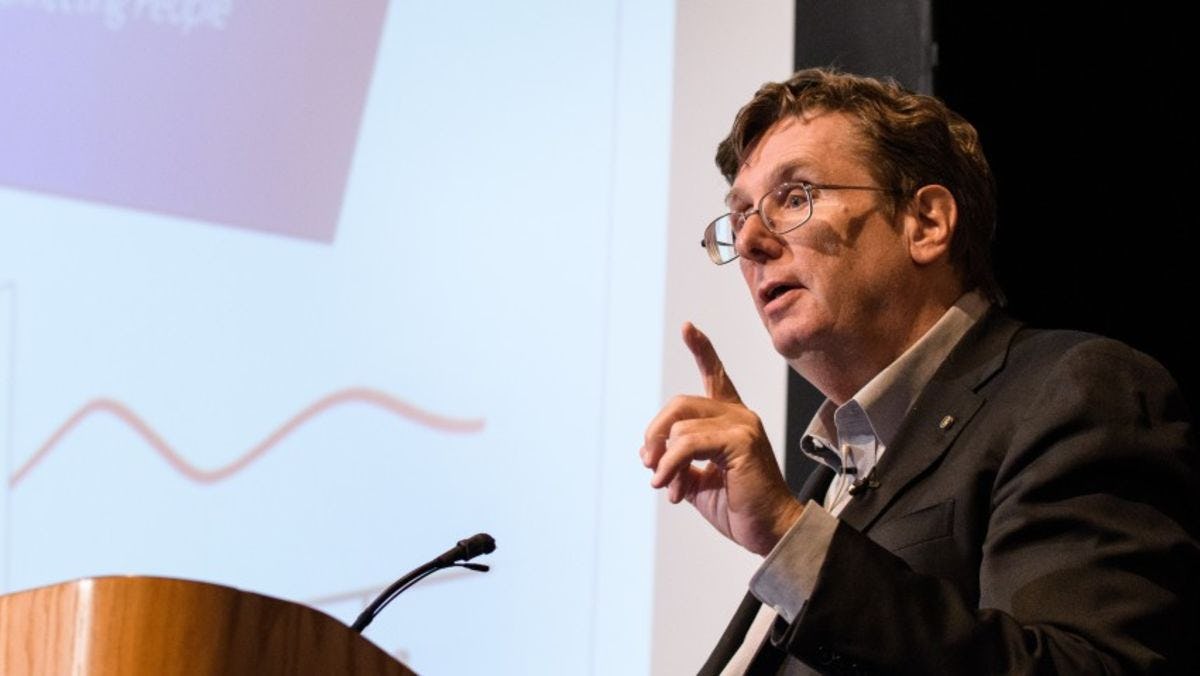Innovating Is Key to America's Future, Says Former SRI Chief — And Stevens Is A Model
10 OCT 2016 CAMPUS & COMMUNITY
Leading technologist lectures on the urgent need for new ideas, outlines methods for innovation development
In a global innovation economy that moves fast and competitively, the U.S. must do a profoundly better job of innovating to create a path to prosperity. To thrive, we must transform the way we innovate and teach our workforce an essential skill — the ability to continuously create new innovations.
That call to action was given by Dr. Curtis Carlson, an influential technology leader who has advised emergent companies, governments and educational institutions on innovation, competitiveness and educational reform, as the eighth speaker in the President’s Distinguished Lecture Series at Stevens Institute of Technology October 6.
Carlson is the founder and CEO of Practice Innovation and the former president and CEO of SRI International, one of the world’s preeminent research and innovation centers. In an hour-long lecture, he provided a fascinating look into the innovation practices of the renowned Silicon Valley research institute, where he oversaw the development of the some of the most significant tech developments of our time, including Siri (prior to its acquisition by Apple) and transformative technologies such as HDTV and Intuitive Surgical.
Opportunities and challenges
With $20 trillion in opportunities over the next 10 years in the global market, now is the best time to be innovative in technology, Carlson asserted. The rapid growth of new technologies, such as next-generation internet, nanotechnology, satellite technology and digital education, is challenging the traditional business model of every major industry, he said.
“In the sharing economy, we have companies such as Uber attacking the traditional taxi-cab industry. Automation is everywhere – driverless cars, robotic manufacturing and service robots – and AI personal assistants [are] in the service and financial services industries.”
But as much as technology is creating the potential for great prosperity, it is also shortening the life span of new businesses.
“More companies are going away than being born. At the turn of the 20th century, large companies would last for 100 years. Today it’s 15 years or less,” noted Carlson, who used Nokia as a cautionary tale of a company that did not adapt fast enough to the complete transformation of the mobile ecosystem brought on by the iPhone.
The fierce competition confronting the U.S. in a fast-changing global market has already begun and will only increase exponentially in the coming years, he warned.
“In China, three or four cities the size of New York City are being born every year, with a million people a week moving from the countryside into the cities. They’re going to be competing with us and everybody else in the world.”
As it stands now, the U.S. has vastly underperformed in preparing its workforce to compete in the new world economy, opined Carlson, who delivered a stinging critique of an American educational system that fails to emphasize the importance of innovative learning and the kinds of project-based curricula that teach students how to learn fast and focus on the "big ideas."
Looking to Stevens as a leader
Innovation is a mystery to most people, and often misunderstood, continued Carlson. An invention is not an innovation, he emphasized, even if it is patented.
“There has probably been [a lot of] wasted effort placed on building new ideas for mousetraps that nobody wants,” he said. “Innovation is when we deliver new sustainable value to society. It is always at first surprising, and then expected.”
Carlson laid out a series of useful value propositions from his time leading SRI that he refers to as the NABC method: Needs, Approach, Benefits (per costs) and Competition.
“For every initiative, we worked closely with clients to articulate their important needs; define the most compelling and unique approach to address their needs; analyze the benefits per costs of that approach; and quantify why the chosen approach was better than the competition and alternatives,” he explained.
Failure to appropriately satisfy each of the four NABC value propositions in a simple, compelling manner is the reason most companies fail from the start, he lamented. And few organizations, whether in government, industry or academia, possess the processes for innovation and value-creation needed to identify and systematically develop major new opportunities.
The U.S. must do more to prepare workers for long-term success — and the way to do that, he stressed, is to emulate what is happening at Stevens.
“We need to move toward a first-class education that not only teaches technology but also the disciplines of innovation. Graduates today need to learn those skills if they’re going to thrive not just in the next ten years, but for the next 50 years.”
The President’s Distinguished Lecture Series, which launched in fall 2012, offers unprecedented access to influential scientists, technologists, policymakers and business executives at technology driven companies who are shaping 21st-century society in direct alignment with Stevens’ own mission. The series focuses on important topics in science and technology, the linkages between societal issues and advances in science and technology, and related policy issues.
